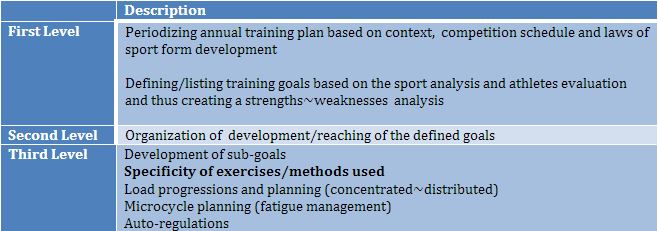In the last installment of the Powerlifting Programs series, we analyzed the critical training variables that must be manipulated properly in order to satisfy the core, foundational principles of all good powerlifting programming. Namely, we discussed intensity, volume, and frequency.
Our previous discussion analyzed these topics only in relation to each other. In this article, we’ll endeavor to put these concepts into the context of an actual powerlifting program. In other words, the primary focus of this writing is going to be the planning and organization of powerlifting training. We’ll use ProgrammingToWin’s concepts of the “novice”, the “intermediate”, and the “advanced” athlete as hypothetical lifters for whom we are designing a training cycle. This will better help us understand these concepts in the context of reality.
If you’d prefer to watch rather than read:
Overview
Mladen Jovanovi?’s concept of the three-level model to training organization is going to be central to our discussion:
At the highest level, we have to develop a competitive plan for the athlete based on the realities of the calendar. We have to answer questions such as: when is the next meet, how many weeks do we have to prepare, what are the training objectives, and several others we’ll soon discuss.
Dropping down to the next level, we arrive at periodization. Periodization is the process by which we organize, combine, and plot the timeline of training goals. For example, the early part of a powerlifter’s “off-season” (in-between meets) may be dedicated primarily to muscular hypertrophy. As the meet draws closer, the training focus would likely shift more towards improving maximal strength. In this case, the exact length of each period, the method of transition between periods, and the level of emphasis on particular training objectives during each period is the very definition of “periodization”.
Finally, we get to familiar territory. The third level deals with programming. By my definition here, programming entails the actual manipulation of volume, intensity, and frequency to produce the training effects that the periodization plan calls for.
The Novice Powerlifter
To best understand the interplay between the different levels of planning, I think working our way through a number of hypothetical powerlifting case studies is appropriate. First, we’ll begin with novices.
In Practical Programming, Mark Rippetoe pioneered the idea that “novice”, “intermediate”, and “advanced” athletes all require different periodization lengths in order to optimize rates of progression. By Rippetoe’s definition, a “novice” is a lifter who can perform a workout which stimulates an adaptation and recover from that workout in time for his next training session. In simple terms, a novice can set a PR on the squat on Monday and, by the time Wednesday rolls around, they’re ready and capable of doing setting another one.
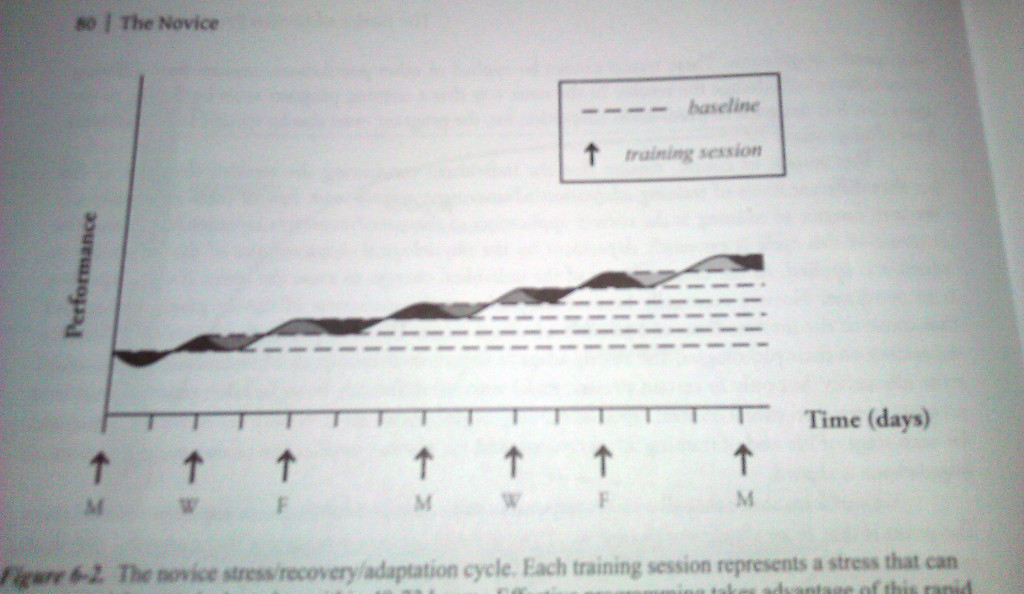
You can see that the novice goes through a full stress-recovery-adaptation cycle between each workout.Photo: Practical Programming 3rd Ed, Mark Rippetoe, 2014.
For novices, the competitive plan is always going to entail improving everything. Primarily, they need better technique, more muscle, and more strength.
Now, in terms of periodization, it is completely inappropriate to organize a novice’s training into distinct periods where each training objective is focused upon for a given time before another then assumes the emphasis. One of the hallmarks of the novice is that they require very little volume in order to make progress. Because of this, novices can, and, indeed should, develop all of their training objectives simultaneously – this is called Complex-Parallel Periodization. Even combined, the amount of volume they need to improve their muscle mass, technique, and maximal strength will not be enough to overwhelm their adaptive capacity.
Additionally, when we talk about programming for a novice, the truth is that it is unnecessary to manipulate intensity and volume within a given training week or training period. Optimizing volume for a novice is as simple as making sure that, each session, they do enough to produce an adaptation and not so much that they can’t recover in time for their next session. Variety in volume just isn’t needed.
Because the novice is so readily capable of improving all physical attributes simultaneously, it makes a great deal of sense to pick an intensity range, such as 80-85%, that will provide a nice blend of technical improvement, increased muscle mass, and improved maximal strength. Lately, and perhaps traditionally too, sets of five have been used for this purpose. 5s are appropriate for the novice because they offer a nice blend of size and strength without introducing too much of a muscular endurance component that often interferes with technique development in the novice lifter.
The Intermediate Powerlifter
Returning to Rippetoe’s definitions, an intermediate trainee is one who can no longer sustain workout to workout performance improvement.
For the intermediate, the loads required to produce an adaptation require recovery periods substantially longer than 48-72hrs. As such, during the intermediate phase, programming variety becomes necessary. That is, intensity and volume must be manipulated.
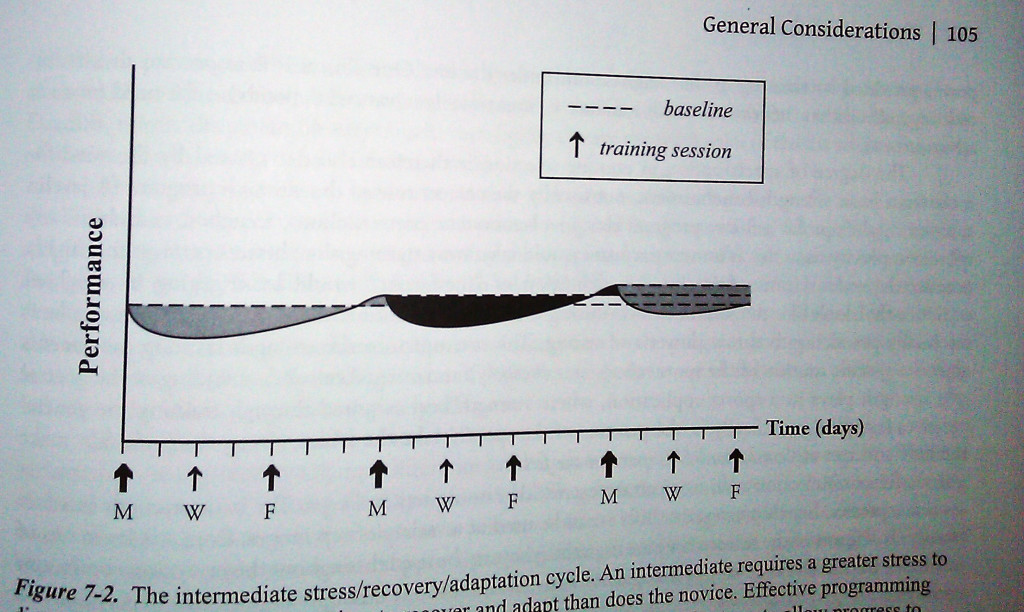
In this example, the intermediate requires a full week to complete each stress-recovery-adaptation cycle.
Photo: Practical Programming 3rd Ed, Mark Rippetoe, 2014.
Consider the Texas Method.

In Rippetoe’s Texas Method, Monday serves as the volume stimulus, Wednesday serves as a light day which allows further recovery but helps prevent detraining, and on Friday the lifter demonstrates their performance improvements by attempting a PR. Each week, the cycle is repeated.
The competitive plan for the intermediate is markedly different from that of the novice. By the time a trainee reaches the intermediate phase of strength training, they should be participating in meets. As such, the meet calendar becomes an important consideration in the overall competitive plan.
Nonetheless, in terms of periodization, the Complex-Parallel approach remains entirely appropriate. Intermediates generally do not require periods of specific focus on individual performance attributes. Programming variety and load manipulation is all that is required to sustain progress.
Mesocycles and Microcycles
At this point, I need to introduce the concepts of mesocycles and microcycles. For the novice, each workout and the following recovery period constitutes both an entire mesocycle and microcycle. Using the weekly Texas Method model discussed above, Monday, Wednesday, and Friday would all represent microcycles, each with an individual purpose, and each training week would represent a full training mesocycle.
Mon: Volume Day – Microcycle
Wed: Recovery Day – Microcycle
Fri: Intensity Day – Microcycle
Each full Training Week: Mesocycle
You can easily see how the “Texas Method” model could be applied to a three week wave rather than taking place inside of a single week. In this case, each week, with its particular volume and intensity combination, would represent a microcycle and the full three weeks would constitute a mesocycle.
Week 1: Volume Week / “Accumulation” – Microcycle
Week 2: Recovery Week / “Deload” – Microcycle
Week 3: Intensity Week / “Intensification” – Microcycle
Each Three Week Wave: Mesocycle
My Definition of Intermediate
Rippetoe’s definition of the intermediate trainee ends when the lifter can no longer sustain PRs on a weekly mesocycle. However, personally, I find it more useful to consider an intermediate trainee as anyone who can still use a Complex-Parallel approach to their periodization.
While the novice-intermediate-advanced categories presented by Rippetoe are incredibly novel and quite useful in some contexts, the truth is that level of adaptability exists along a continuum. A week is just an arbitrary measure of time chosen by human beings for social convenience. At one point in the intermediate stage, you may only need 5 days to complete a full adaptive cycle, but, as you get stronger, you’ll eventually need 7 days, then 9, and so on. The relationship between volume and recovery is not only different for everybody, but it is constantly changing as an athlete makes progress.
Making distinctions based on the length of each training mesocycle and microcycle quickly loses utility. For that reason, as stated above, I prefer to define an intermediate as any trainee who can still make progress on all physical attributes equally and simultaneously so long as volume and intensity are properly manipulated.
The Advanced Powerlifter
Eventually, an athlete will reach the point where the volumes required to stimulate further improvements in specific physical attributes are so high that it becomes physically impossible to continue developing them simultaneously.
While it is true that work capacity and recovery ability improve over the course of an athlete’s training career, they do so in absolute terms. For everybody, there is an upper limit to recovery. When this point is reached, an athlete will risk overtraining if they continue to hammer away at the Complex-Parallel approach.
When this begins to happen, most athletes turn to performance enhancing drugs to artificially raise their overall recovery limitations. This allows them to simply add more volume rather than increase periodization complexity.
However, there is an alternative: Block Periodization. Block Periodization uses planned training periods, or mesocycles, to focus upon specific physical attributes such as muscular hypertrophy, maximal strength, or explosive strength. In the very strictest of Block Periodization interpretations, only one quality is focused upon per period. The blocks are organized in strategic order so that the effects of the previous block carryover positively into the next.
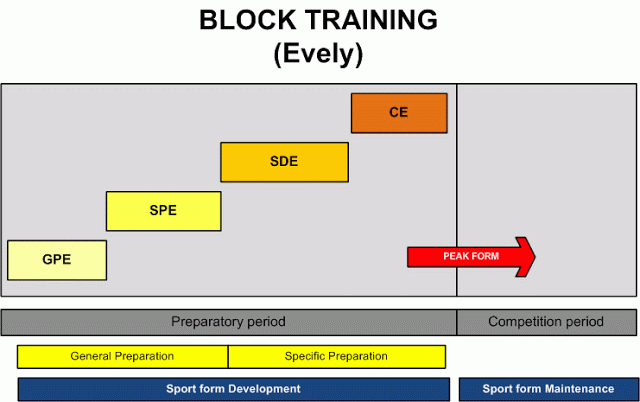
As you can see, with block, each quality is developed sequentially. The acronyms aren’t important: substitute any qualities you want into the boxes.
Pendulum / Emphasis Periodization
So, on one end of the spectrum, we have Complex-Parallel periodization where virtually all physical attributes are trained simultaneously and, on the other, we have Block periodization where each quality is trained in isolation. As you might have already realized, the reality is that the vast majority of us will benefit most from something in-between the two extremes.
One very intelligent approach is the Pendulum/Emphasis periodization scheme. In the off-season, for example, 67% of our training might be directed towards muscular hypertrophy whereas only 33% would be placed on improving maximal force production. For “early” advanced trainees (remember, it is a continuum), this will result in small improvements in maximal strength and large gains in muscular hypertrophy. As the training cycle progresses, the pendulum would swing and the emphasis may become 67% maximal force production. In this manner, multiple physical attributes are improved simultaneously, but the loading is concentrated in a particular direction.
It is my opinion that this Pendulum/Emphasis style of periodization is going to be optimal for most powerlifters with multiple years of training experience.
Summary
Whenever we’re organizing our training, the first thing we have to take into consideration is the competitive plan. When is the next meet? How many weeks do we have? What classification of athlete are we?
If we’re a “novice”, very little planning and training variable manipulation is required. The novice can use a Complex-Parallel periodization, improve all important training qualities simultaneously, and do it without variety in intensity and volume from workout to workout.
Now, if we’re an “intermediate”, by definition, we’re going to require variety from microcycle to microcycle in terms of intensity and volume. Typically, intermediate programs call for periods of “accumulation” (higher volume) and “intensification” (low volume, but heavy weights). The length of the accumulation and intensification would depend on the intermediate trainee’s exact level of adaptability. They might be operating within a weekly mesocycle such as the Texas Method or they may be using a monthly mesocycle such as Jim Wendler’s 5/3/1.
Only advanced trainees require more complex periodization models. For the advanced athlete, the volumes required to spur progress in any given physical attribute are so high that it is simply impossible to develop them all simultaneously. As such, periods of emphasis on specific attributes become necessary and this is where block periodization enters the picture. Not only does the advanced athlete have to incorporate complex programming models that appropriately manipulate volume and intensity, but they have to layer that manipulation in with the objectives of their periodization plan at the determined times in their training cycle.
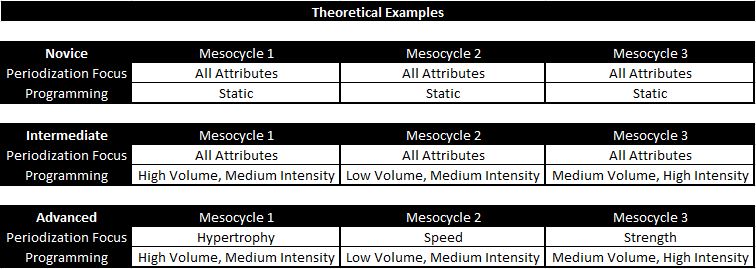
You can see that as you reach each new stage of training advancement, a level of complexity is layered into the training.
Moving Forward
I did my absolute best to simplify the academic monster that is training organization in this article. However, for those of you out there for whom anything is still murky, please feel free to ask! I will do my best to help. Additionally, I’d highly recommend snagging a copy of Practical Programming for Strength Training if you’re looking for further academic understanding.
Moving forward, we’ll begin our analysis of popular training programs by beginning where I began: Starting Strength.
Did You Enjoy The ProgrammingToWin Series?
If so, you’ll absolutely love our eBook ProgrammingToWin! The book contains over 100 pages of content, discusses each scientific principle of programming in-depth, and provides six different full programs for novice and intermediate lifters. Get your copy now!
Like this Article? Subscribe to our Newsletter!
If you liked this articled, and you want instant updates whenever we put out new content, including exclusive subscriber articles and videos, sign up to our Newsletter!
Questions? Comments?
For all business and personal coaching services related inqueries, please contact me:
[contact-form-7 id=”3245″ title=”Contact form 1″]
Table of Contents
Powerlifting Programs I: Scientific Principles of Powerlifting Programming
Powerlifting Programs II: Critical Training Variables
Powerlifting Programs III: Training Organization
Powerlifting Programs IV: Starting Strength
Powerlifting Programs V: StrongLifts 5×5
Powerlifting Programs VI: Jason Blaha’s 5×5 Novice Routine
Powerlifting Programs VII: Jonnie Candito’s Linear Program
Powerlifting Programs VIII: Sheiko’s Novice Routine
Powerlifting Programs IX: GreySkull Linear Progression
Powerlifting Programs X: The PowerliftingToWin Novice Program
Powerlifting Programs XI: Madcow’s 5×5
Powerlifting Programs XII: The Texas Method
Powerlifting Programs XIII: 5/3/1 and Beyond 5/3/1
Powerlifting Programs XIV: The Cube Method
Powerlifting Programs XV: The Juggernaut Method
Powerlifting Programs XVI: Westside Barbell Method
Powerlifting Programs XVII: Sheiko Routines
Powerlifting Programs XVIII: Smolov and Smolov Junior
Powerlifting Programs XIX: Paul Carter’s Base Building
Powerlifting Programs XX: The Lilliebridge Method
Powerlifting Programs XXI: Jonnie Candito’s 6 Week Strength Program
Powerlifting Programs XXII: The Bulgarian Method for Powerlifting
Powerlifting Programs XXIII: Brian Carroll’s 10/20/Life
Powerlifting Programs XXIV: Destroy the Opposition by Jamie Lewis
Powerlifting Programs XXV: The Coan/Philippi Deadlift Routine
Powerlifting Programs XXVI: Korte’s 3×3
Powerlifting Programs XXVII: RTS Generalized Intermediate Program
